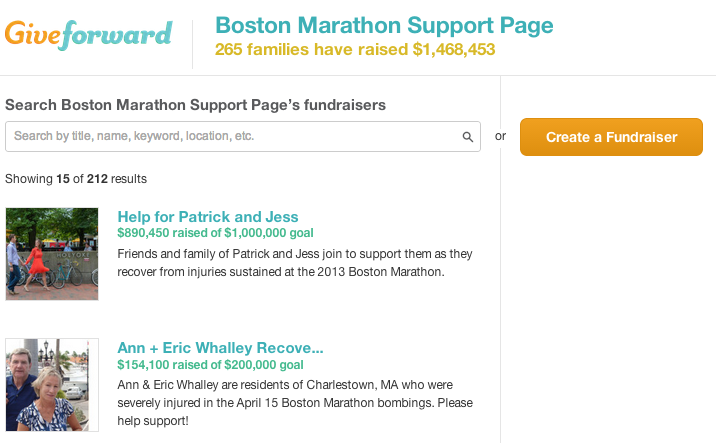You absolutely NEED to check out this blueprint for crowdfunding medical expenses. It’s all about crowdfunding personal expenses. Get Funding for Education,Travel, Volunteering, Emergencies, Bills, and more.
1. Set Realistic Expectations
After hearing about some individuals raising thousands of dollars on medical bill and expense crowdfunding sites like GoFundMe, YouCaring, or GiveFoward, it is tempting to set lofty expectations for a crowdfunding goal.
Unfortunately, according to the stats we pulled together for GoFundMe, the largest crowdfunding platform for personal causes, the average amount raised is $1,126, with 76% of users setting a $1,000 goal or less.
Most of the pledges for these campaigns come from the individual’s social network via direct outreach to friends, family, and their local community.
However, there are exceptions, particularly medical-related issues that capture national attention. For example, Farrah Soudani, one of the victims of the Colorado theater massacre, from thousands of donors.
The key here was that many people had heard of the theater shooting, sympathized with the victims, and wanted to support the affected families in some way. The internet rallied behind this effort to the tune of 6,088 donors over the course of 25 months.
Another example is the horrific Boston Marathon bombing incident. Many individuals were injured and the event attracted national attention. On GiveForward, 262 families who were victims of the Boston Marathon have raised $1,467,238.
Again, the key element here that led to an outpouring of support was that donors knew of the event because of the media and sympathized with the affected individuals.
2. Tap Into Existing Communities
Aside from directly messaging friends, family, and professional connections, it’s important to tap into larger existing communities that you are involved with. This could include your local community, church, and any support groups you are a member of. It’s best if you identify communities that either know who you are or have a habit of taking care of their own (church).
This type of outreach will likely make you uncomfortable, as it’s difficult to ask for financial help from others, but other than friends and family, these groups will be the most likely to donate to your crowdfunding campaign for medical expenses.
There are also a few online communities that you may be able to find like the subreddit r/assistance, though I wouldn’t bank on them making up a good portion of your fundraising.
3. Invoke Emotion in Potential Backers
In a StepByStepFundraising article, non-profit management/fundraising expert Sandra Sims lists the top five reasons why people give to charitable causes:
– Personal experiences;
– They want to make a difference;
– They want to do something active about a problem or take a stand on a particular issue;
– They are motivated by personal recognition and benefits;
– Giving is good thing to do.
Another article in Fundraising123 backs up many of these top motivations for donating to charity or causes.
– Someone I know asked me to give, and I wanted to help them.
– I felt emotionally moved by someone’s story
– I want to feel I’m not powerless in the face of need and can help (this is especially true during disasters)
– I want to feel I’m changing someone’s life
– I feel a sense of closeness to a community or group
Many of these motivations have to do with emotions. When you’re pitching your campaign, consider which emotions you are catering to in your potential donor demographic. Is this an opportunity to change someone’s life, or does your story have strong emotional appeal? How can you highlight people that do donate, to give them that feeling of “recognition”?
4. Be All-In or All-Out When Promoting
I hate to be the one to say it, but you can’t just throw up a fundraising page online and hope for support. It can be humbling at the least and emotionally degrading at the worst to ask your friends and family for financial support, but you need to do it if you want to raise money via this medium.
There is no way to get around it. You either need to be all-in and be willing to spread the news about your medical crowdfunding campaign, or you need to consider an alternative financing method. There isn’t much room for middle ground.
If you’re not willing to do this, there are financing alternatives for your medical bills. You could consider peer to peer lending sites or traditional financing routes. It’s an unfortunate fact, but according to Nolo:
“62% of all bankruptcy filings in 2007 were tied to health care expenses, according to a American Journal of Medicine study… For the most part, medical debts can be wiped out in a Chapter 7 bankruptcy, but it will lower your credit rating for several years.
And if you don’t qualify for the “clean slate” that Chapter 7 bankruptcy can provide, you may need to file under Chapter 13 bankruptcy. In that case, you’ll likely need to make payments towards a portion of all your debts (including medical bills) under a Chapter 13 “reorganization” plan.” – Read more here.
5. Pick The Right Platform
There are many crowdfunding platforms out there that you can use to raise money for your medical bills and expenses. I would recommend checking out our list of online fundraising sites or our list of top personal cause crowdfunding sites. I personally like YouCaring because they don’t charge any platform fees. Still, GoFundMe is the largest and likely the most well-known.
Conclusion
Are you running a crowdfunding campaign for medical bills or expenses? Let me know in a comment below.





